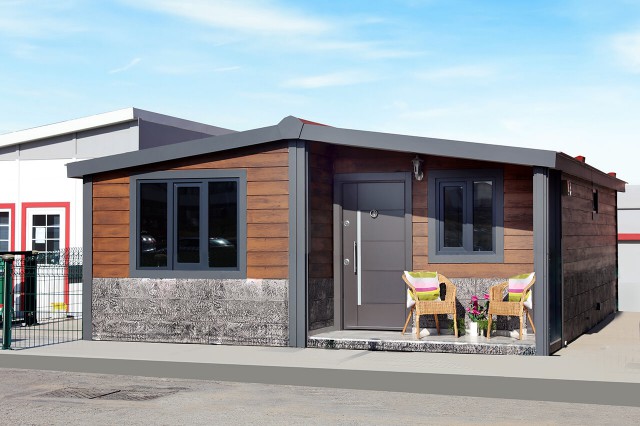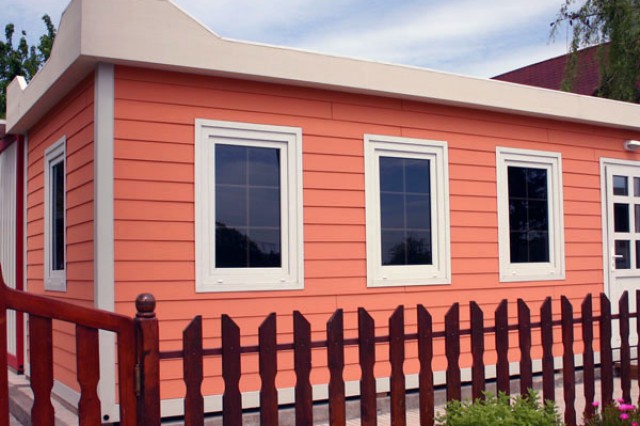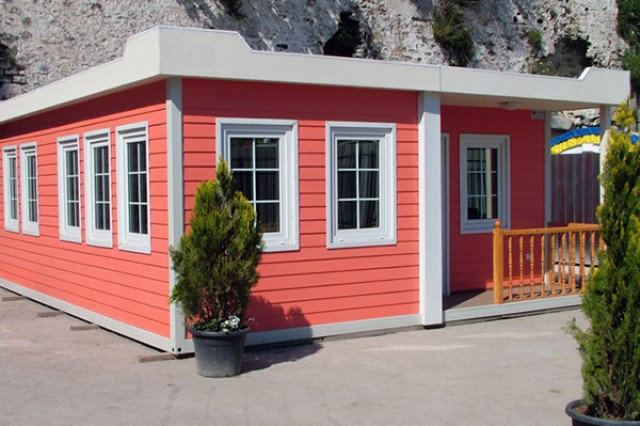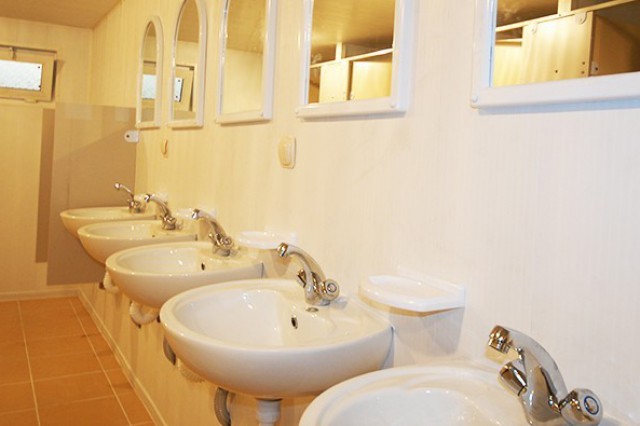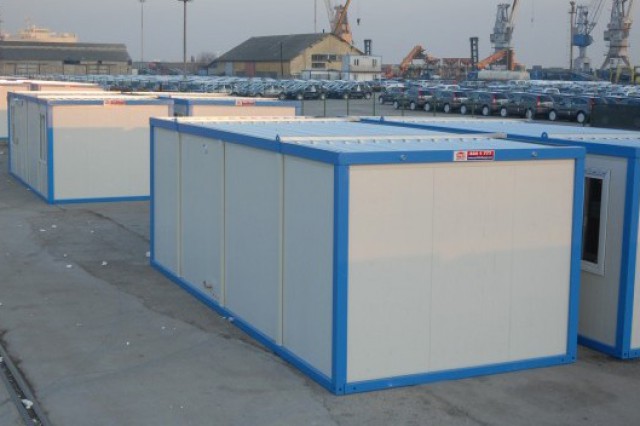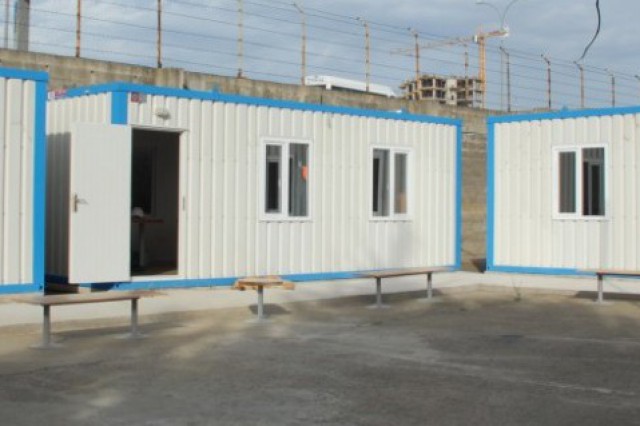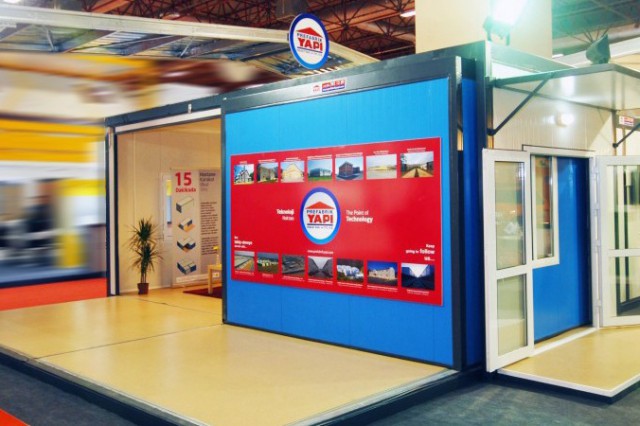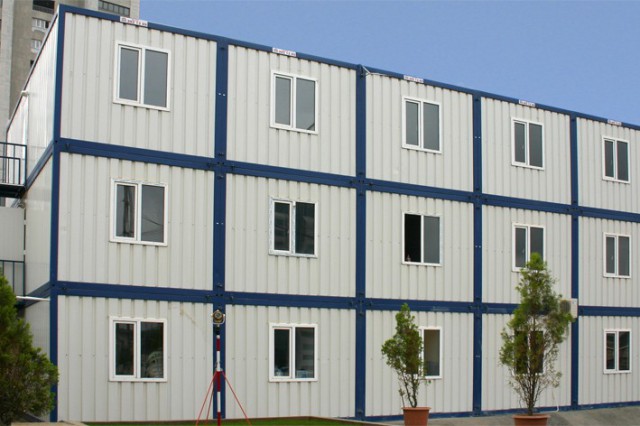Our company, which has always been a pioneer with the innovations and technologies brought to the ready-made building sector since 1989, actualizes the manufacturing of containers for maximum mobilization, aesthetics and functionality. It assured manufacturing guarantee wit its integrated facilities as well. Prefabrik Yapı A.Ş. with a container production capacity is 6750 units/month makes difference with manufacturing guarantee.
Container Types and Usage Areas
Container Product Catalog
Another application area of containers is container house solutions. These structures, which are generally preferred by the end consumer, are mostly used in seasonal, non-zoning land and to meet short-term needs.
In addition to the above major areas of use, containers are also used for educational, health, military and camping buildings with combined container systems.
Container Production Systems
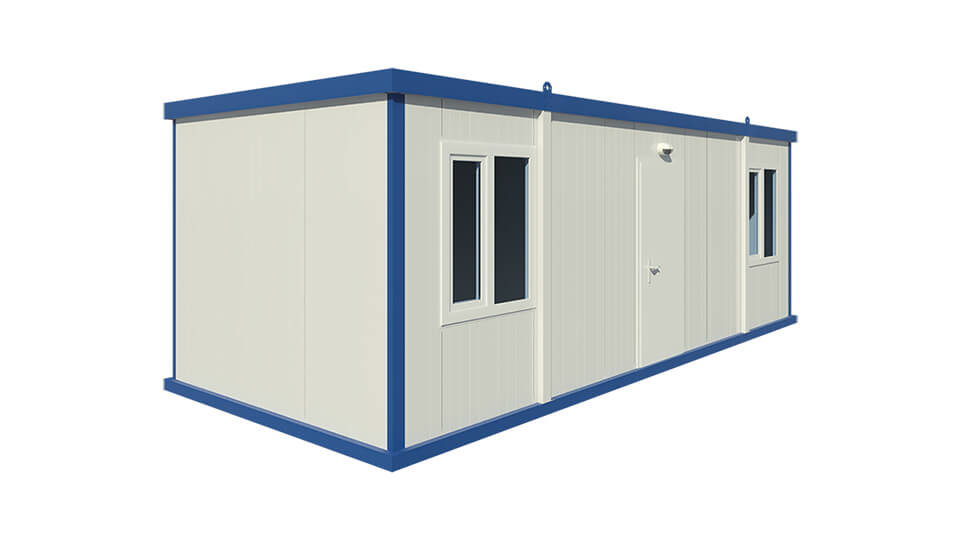
Monoblock Panel System
It is the manufacturing system which makes the product ready for shipment by completing all manufacturing operations in the factory environment of container types, to be used. The assembly of all structural components is completed in the factory environment and then loading and dispatch operations are carried out in this state.

Demountable Panel System
In this manufacturing system, its prefabrication is carried out in the factory environment before the assembling the ceiling and base chassis constituting the container and the components constituting the walls. It is made ready for transportation with special packaging system and shipped to the region where it will be used.
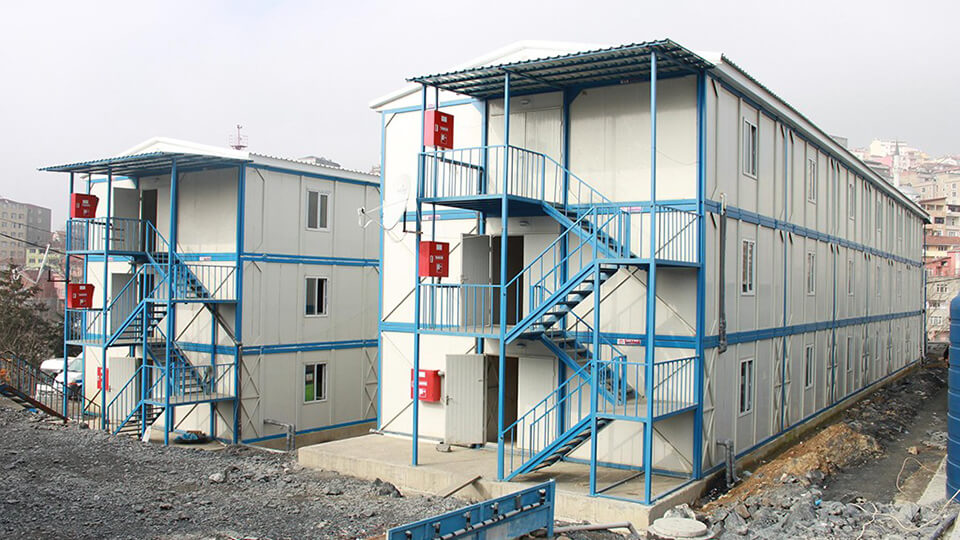
Combined Panel System
It is the manufacturing system used to create multi-storey spaces by assembling two or more containers together. Prefabrication operations are completed in the factory and assembly operations at the location where it will be placed.
Container Production
Containers produced with weldless construction technology and bolt nut connections can be produced as single-storey, two-storey and three-storey according to the geographical characteristics and purpose of use of the place where they will be used. In line with the choice of the customers, painted galvanized sheet or HekimBoard branded A-1 class non-combustible fibercement boards, which make a difference with their superior features, are used in the required surface coatings of the products.
Containers according to the purpose of use, place of use and usage patterns, as Hekim Panel system; They are produced as monoblock, disassembled and combined. Electrical and sanitary installations are designed as flush-mounted or surface-mounted, depending on preference. Apart from standard flat roof applications, pitched roof solutions are also used in cases where additional roofs are required.
Standard container products are produced in two different sizes as 3.00×7.00 m and 2.40×6.00 m. One-phase multi-storey structures in camp and construction site structures can be positioned by combining standard containers. In addition, necessary static calculations can be made in line with the needs and demands of the customers, and special sized containers can be produced according to their suitability.
Why Container?
- Manufacturing is fast.
- low cost.
- shows resistance to different climatic conditions..
- With its weldless connection system, it has higher strength than other varieties.
- Resistant to natural disasters such as earthquakes.
- It does not combust and be affected by water with fibercement boards.
- It is of high quality.
- Easy to dispatch.
- It is used many times.
- Provides ease of loading and installation.
Conditions to be Considered in Container Installation
- The leveling of the ground on which the container will be placed should be ensured. Otherwise, problems may occur in the operation of door and window joinery.
- It must be ensured that the main frame is fully supported on the surface where the container is positioned.
- The container should be connected to 2 × 2 cm lifting lugs in the upper corners and lifted and lowered by crane.
- Ropes must be cross-linked as shown.
- The rope lengths should be equal and the angle with the horizontal should not be less than 20 ° (36% slope).
- The hook should be attached on the large surface and ,it should be lifted after the balance is achieved by shifting the hook to the heavy side
- In order to extend the life of the container, it should be placed on a level surface (concrete etc.) or on battens having a size of short side dimension at an interval of maximum 2.5 meters.
- It should be checked that the door can be opened and closed and locked easily.
Frequently Asked Questions About Container
What material are containers made of?
Containers are manufactured from durable galvanized steel profiles. Especially Hekim Sandwich Panel coated containers do not have any paint, while acrylic exterior paint is sufficient for Hekim Board coated containers.
What can be put under the container?
The foundation or bottom of a container is typically made of concrete. It provides a solid, flat surface for the container to rest on and helps secure maintenance. The base must be designed to withstand the weight of the container and the additional loads that heavy equipment or people will appropriately impose. In some cases, a container may be placed on a gravel or crushed stone foundation rather than a concrete foundation, but concrete is generally considered the strongest and most durable option
How are containers produced? What ingredients does it contain?
The production process begins by cutting the panels of sizes determined according to the purpose and area of use of the container. Subsequently, the main carrier system of the container is formed by combining the panels and galvanized steel profiles, of which the walls, roof and floor are shaped, with bolts. Hekim sandwich panels are fixed by placing them on the appropriate sections of the carrier steel profiles and form the container. Then, equipment for systems such as doors, windows, ventilation and locking are mounted on the container. Hekim Sandwich panel covering material is used as wall and ceiling material in containers. EPS, polyurethane foam or rock wool is used as insulation material in the production of sandwich panels. Production is carried out by adding PVC, parquet or carpet floor covering on the base chassis of windows, doors, electrical installation areas, plumbing areas. Before the manufactured container is shipped to its user, it undergoes a final inspection to ensure that it meets the required safety standards and is in good condition.
What should be considered when setting up a container?
There are several factors to consider when installing the container to ensure that it is correctly configured and safe to use. Some of these factors include:Position: The position of the container should be chosen carefully to ensure that it is level, stable and secure. A solid and flat surface container that can support the weight of the material is suitable.
Floor: Before the containers are placed, the ground must be prepared so that it is stable and level. Some of these preparations include leveling, compacting or adding soil.
Fixing: The container must be fixed to the ground to prevent it from moving or tipping over. Containers can be fixed by various methods using steel profiles, bolts, nuts and similar anchoring materials, concrete blocks.
Ventilation: Proper ventilation is important to keep the inside of the container dry and prevent mold and mildew. A ventilation system (culvert, fan, etc.) can be installed on the container wall to keep the inside of the structure at the appropriate dryness.
Fire safety: Smoke detectors, fire extinguishers, emergency exit points should be available in case of any emergency that may arise during container use.
Customization: If containers are to be used for a specific purpose, such as office or living space, they need to be customized to meet the specific needs of the project. By adding walls, doors, windows and other features, the container can be customized for its intended use.
Maintenance: As with every material, containers must be maintained regularly to remain in good condition and have safe use. The container can be made longer-lasting by regular and correct cleaning, repair and inspection.
How to get electricity to the container?
Methods of generating electricity for containers may vary depending on the location and regulations of the region, budget and availability of energy source. In order for the installation to be carried out safely and to be used in accordance with the regulations, an application should be made by contacting the local administrations such as the mukhtar’s office and the municipality to which the area where the container is located is affiliated. Especially for the electricity use and subscription of containers to be used in construction sites, a transformer or main electricity distribution panel connected to the existing subscription belonging to the official authority of the construction site can be installed. In addition, some of the other methods of accessing electricity are:
- Grid connection: The container can be connected to the local electricity grid. An electrical line can be run from the nearest electrical source or transformer to the container, and a meter can be installed on the structure to measure usage.
- Jeneratör: Benzin, dizel veya proplanla çalışan portatif jeneratörler, konteynere elektrik sağlamanın bir yoludur.
- Solar energy: Electricity can be obtained by installing solar panels on the container roof. The panels are connected to a battery bank, an inverter is used to convert DC power to AC power.
- Microgrids: Microgrids, which are small-scale power systems connected to the main electrical grid, can be powered by a variety of energy sources such as solar, wind and generators.
- Grid connection: The container can be connected to the local electricity grid. An electrical line can be run from the nearest electrical source or transformer to the container, and a meter can be installed on the structure to measure usage.
How to get container electricity subscription?
Depending on the purpose, the subscription procedures required for the electrical system to be connected to the container may vary. For containers to be used as houses, it is necessary to apply to local governments such as the headman’s office or municipality to which the region is affiliated. If it will be used within the construction site, the connection can be made by drawing a line to the existing subscription main electricity distribution panel of the construction site authority or to a transformer. Wind turbines or solar panels may be preferred for places without electrical infrastructure.
How much is the penalty for placing a container in the field?
The penalty for placing containers on site without proper permits varies depending on jurisdiction and circumstances. In many cases, it can be considered illegal dumping or unauthorized use of land and can result in fines, penalties, or even criminal charges. The severity of the penalty will depend on factors such as the size of the container, the location of the site and the impact on the environment. To avoid penalties, it is important to obtain the necessary permits, licenses and approvals before placing containers on site. Additionally, it is important to comply with all local zoning laws, ordinances, and environmental protection codes to ensure your container location is legal.
How much do container houses cost?
Container prices may vary depending on various factors. Size is a factor that affects prices. Prices may increase as size and volume increases. Since new containers have not been used before and are manufactured with special materials, they have higher prices than used options. The features of the container affect its price. Containers with additional insulation, lighting and electrical connections have different prices compared to others. In addition, since containers produced for office, accommodation and other facility purposes are produced specifically for certain uses, they may be more expensive than others due to different additional material or production costs.
How to get a container house permit?
The process for obtaining a permit to build a container home varies depending on local ordinances and building codes in your area. Local zoning and building codes generally apply. Once you confirm that building a container house is allowed in your area, you need to obtain a building permit from the local building department. You may then work with an architect or engineer to design the container, and you may need additional planning and regulations throughout the construction period to ensure the work is done in accordance with building codes and standards.
How to make a container base?
It is important to process the base on surfaces that are free of rocks, stones and other debris. After the ground is excavated and the concrete legs are poured, the container is placed on the foundation. A base chassis is created to support the container parts. Base production is completed after Hekimboard floor covering is applied on the resulting base chassis. It can be covered with any desired floor covering material such as PVC, parquet, carpet or similar.
How should the container floor be?
The floor of the container must be strong, flat and durable enough to support the contents of the container and the weight of the people and equipment that may be inside it. It is usually made of wood, steel or concrete and must be treated to resist moisture and pests. It is important to ensure that the bottom of the container is level and secured to the base to prevent slipping or collapsing.
How is container siding done?
Exterior cladding can be done with Hekim Sandwich Panel or Hekim Board surface coating material. In addition, decorative siding, stone patterned fibercement or jointed fibercement can be used upon request. The coatings are made with A1 class fireproof and water-resistant cellulosic fiber cement-based HekimBard Brand fiber cement boards. The installation process of the exterior cladding may vary depending on the material used and the tools and techniques used. In general, it is important to ensure proper siding to prevent moisture from penetrating the interior of the container.
How to make a roof on a container?
You can apply roof systems in accordance with the architectural design of the previously prepared roof on a structure consisting of a container or a combination of containers. ; Gable roof, hipped roof, steep roof, single-pitched roof, chassis roof, etc.
How to transport container?
Transportation of the container within the construction site can be carried out by different methods depending on factors such as size and area of use. Flatbed trucks are one of the vehicles that will help when transporting containers. Using a crane or other lifting equipment, the container is loaded onto the truck and transported to the relevant area. If the construction site is near the railway, the container is transported to the nearest train station and then transported to the construction site by a truck. For small sized containers, the container can be transported on site with a special trailer that helps in loading and unloading the vehicle. Crane support must be provided for horizontal and vertical transportation of containers.
How is container assembly done?
Container assembly generally involves sourcing and properly securing components and assembling them. Container assembly should be carried out by a team of experts in the field in order to avoid any problems during the assembly process, which is at least as important as the production process, and to ensure the long life of the container. The installation process may vary depending on the type and size of the container. Components such as walls, roofs and floors of containers with standard dimensions such as 3.00 m x 7.00 m or 2.40 m x 6.00 m are placed on a flat surface. After the container floor chassis is placed on the balanced surface, bolts, nuts, screws, etc. It is fixed to the walls via First of all, after the wall edges are aligned, the connection is ensured by aligning with the appropriate bolt or screw. After the assembly of the walls is completed, the roof is placed on the supporting columns and walls in the corners with the help of bolts. Afterwards, installations such as doors, windows and ventilation are made. Electrical and other works, plumbing etc. After installation, silicone application and, if necessary, painting or additional coating are carried out.
How is container thermal insulation done?
It is important to choose the right insulation method depending on the specific needs of the project and the intended use of the container. In addition, it is necessary to seek professional help to ensure that the insulation is installed correctly and complies with the regulations and safety standards of the region. Thermal insulation for the container can be done in different ways depending on the specific needs of the project and the intended use of the container. Some common methods are as follows:
- Double glazing: Double glazing can be made to better insulate container windows. This method can be applied with two glass layers with a leak-proof air gap between them to provide insulation.
- Contact us to learn about special offers of Prefabrik Yapı A.Ş.for your demands to achieve long-term results with different container solutions instead of letting land and logistical difficulties hinder your projects.. Learn by trying to find out how customizable and durable containers can benefit your project!
- Double glazing: Double glazing can be made to better insulate container windows. This method can be applied with two glass layers with a leak-proof air gap between them to provide insulation.


